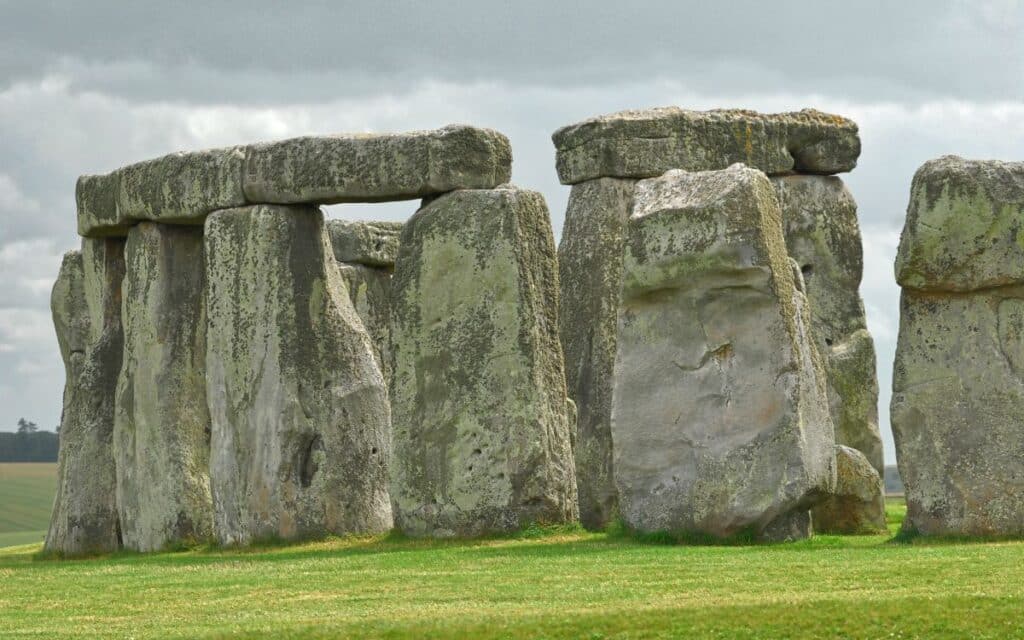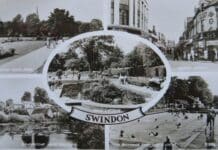Author, researcher and ritual magician JON KANKEO-JAMES looks at the mystical ancient monument of Stonehenge in Wiltshire

Stonehenge, a lonely set of standing stones surrounded by clusters of barrows. The site appears to have been evolved from around 3000BC to 1600BC.
The earliest version of the site, a ditch and earthwork, might have been surrounded by a wooden palisade, possibly with stones having been brought from as far as Wales to act as grave markers.
After time some sort of cremation building was erected on the site, followed by an avenue that might have been used for rituals marking rising sun during the solstice.
In fact, the idea of Stonehenge’s use for astrology is still hotly debated among archaeologists, even contributing to the specialised field of Archaeo-astronomy.
The first theory that Stonehenge was a computer came from before 1740 and was still being championed in 1965.
William Stuckley, the first archaeologist to suggest that Stonehenge was a tool for tracking and measuring astronomical phenomena, noted that the structure has a north-east facing earthwork called ‘The Avenue’, which terminates with the sun almost rising above a stone known as ‘The Heelstone*’ on the morning of the midwinter solstice (although skeptics point out that the sun won’t rise precisely over the stone until the year 3260AD, which would be a strange thing for neolithic builders to be marking… unless it’s the year day when great Cthulu rises to eat us all).
Other archaeologists, like C.A. Newham, put a lot of meaning in a set of postholes (or possibly just the cavities left by tree roots) when the monument’s car park was extended in 1966, believing that they were useful for tracking a number of solar and lunar phenomena.
Other Astro-archaeologists have raised astronomical links with the Station Stones, a vaguely rectangular arrangement of stones just outside the main part of the monument.
Alexander Thom and others have argued that it’s possible to make no fewer than eight astronomically significant sight-lines using the stones, although Christopher Chippendale, in Archaeology, a magazine published by The Archaeological Institute of America, said that modern research has revealed that only three of those sight lines were astronomically relevant, and two of those lines were perpendicular.

One of the most interesting, and macabre, factors of the uses of Stonehenge as an astronomical tool relates to the Aubrey Holes, compacted chalk pits discovered by the 17th century antiquarian John Aubray, who found that there were bodies buried in the pits; a New Zealand-based researcher has also found that the holes – with knowledge of the moon’s movements and how lunar phases affect the sea – can be used to predict tides in the English Channel with uncanny accuracy. Were the dead some sort of sacrifices to the gods of Astronomy, or to the moon?
The general consensus is that while Stonehenge, like other Barrows and ritual sites in Britain, might have been constructed so that the sun hit particular parts of it at particular times of the day and year probably wasn’t a piece of precision engineering for calculating tides and landing spaceships.
Regardless of whether Stonehenge was, as Archaeologists in the University of Missouri have called it, ‘Mankind’s Oldest Computer’, it was certainly a place of death, and an evocative site that has captured the imaginations of people since time immemorial. The ditch outside is full of animal bones, and a lone warrior, the Stonehenge Archer, seems to have been buried to guard the site (along with two compatriots, also archers, at Amesbury and Boscombe). And it’s a fact that the site does have one legitimately creepy story that can be proved as true: the Jamesian story of a disappearing, shape-changing carving discovered by Dr. R E Kaske in 1972.
In his article for Fordham University’s Traditio publication, Kaske writes: “In May 1972, on a casual visit to Stonehenge, I noticed what appeared to be an incised cartwheel with eight spokes, low on the southeast side of stone 30 [one of the large standing stones on the north-eastern part of the site], within the main entrance; this same apparent design was immediately recognised by my wife and son, with no prompting from me.
When I re-examined the area in July 1974, I was astonished to find not only that I could see no cartwheel, but that I could see nothing which might plausibly have led me to think of a cartwheel. This striking discrepancy between two clear visual impressions of the same surface made me suspect that some delicate trick of lighting must be involved, and I accordingly visited Stonehenge at night to explore the problem with the help of cross lighting. Instead of a cartwheel, there emerged the outline of what appears to be another dagger… but carved in relief and set within a rounded depression that I suppose might be partly man-made…”
So cross-lit from one direction, it looks like a cartwheel, from another it looks like a dagger. I’ll be honest, Dr. Kaske gets significant respect from me just for having the nerve to be in Stonehenge at night. I don’t think I’d want to be so near to so many barrows, if nothing else. If this was an M R James story, Dr. Kaske would then have been haunted by the ghost of the Stonehenge archer until he burned his photographs of the site; if it was a H P Lovecraft story he would probably have been eaten or driven mad by elder gods. Personally I still find such a precisely carved optical illusion pretty creepy when it’s on such an old site. It makes the idea of the stones being built for some pre-planned future conjunction of the sun and moon a little more persuasive.
And there are some other strange stories linked with the site: Geoffrey of Monmouthshire’s romantic stories about the site Merlin are well known, but local people believed that not only did the stones have the power to control weather, but they could use it to defend themselves.
When John Wood surveyed Stonehenge in 1747 he was was driven back twice by terrible thunderstorms. It was even believed well into the nineteenth century that the stones could not be counted, with one coachman in 1779 saying that ‘it was impossible to tell them, and no one ever did, as they would actually die if they attempted it.’ Did anyone count the stones and live to tell the tale? Sadly†, yes: John Evelyn, Samual Pepys, Inigo Jones and King Charles II all tried and succeeded to count the stones. Although, it’s a fact that each one of these visitors came up with a different number.
Geoffrey of Monmouthshire, whose wild ‘histories’ attracted the comment from historian Lewis Thorpe ‘much… of his material is not acceptable as history… yet history keeps peeping through the fiction’ also characterised it as a place where 460 British warriors were killed ‘by order of Hengest the Saxon’, something that resonates with the fact that there are over 300 Bronze Age barrows scattered around the immediate area.
In Geoffery’s time the dead were not known for staying dead in their tombs, and neither were barrows always human: elves and goblins we’re able to live in tombs as well.
One Anglo-Saxon charm against being elf-shot directly mentions barrows:
“Loud were they, lo, loud
When over the barrow they rode:
They were of stout mood
When over the land they rode.”
— (Cockayne 1865: 53)
In Felix’s Life of St. Guthlac, the eponymous saint goes out to a particularly cursed mound in the Fens, where he builds a house in the hollow caused by grave-robbers digging their way into the mound, enduring a constant assault from the evil and wicked spirits of ‘evil murders and criminal ravagers’ before eventually getting the upper hand over the demons and driving them back to hell. That’s what I imagine when I think of Stonehenge, a lonely structure on a plain surrounded by barrows full of the restless dead. I’ll leave you with a section of the Anglo-Saxon poem Beowulf, talking about the dragon living in the burial mound…
“The ravager of the night,
The burner who has sought out barrows from old,
Then found his hoard of undefended joy.”
— Alexander, Beowulf, 1987, p.122
* Actually, according to archaeologist E Herbert Stone the sun would rise 1’ 8” to the left of the stone’s peak, which is probably precise enough for religion.
† I’m not sad that no-one died, it would have just been a little more spooky for the purposes of this article if there weren’t plenty of high-profile survivors proving the myth untrue.
Powerful Mystery Surrounds Stonehenge, says Tressa Yeomans
TRESSA YEOMANS, director/founder of Rugeley Supernatural Society, says the mystery of Stonehenge is powerful and that the ancient monument raises more questions than will ever be answered.
Stonehenge, the ancient stone monument in Wiltshire, has always had a hold over me. From its history to its many stories of why it was built, one look at the structure and you are mesmerized by its power.
Built in three stages, it is believed that Stonehenge was built as a sacred monument used for meetings and religious purposes. Many stories have been published of why people think it was built and used for.
The construction of the monument is most often incorrectly credited to the Druids – but the Druids appeared several thousand years later in history – Stonehenge was definitely not built by Druids!
Stonehenge has fascinated people for thousands of years. The monument dates back so far that it is shrouded in mystery, and for thousands of years people have speculated over the true purpose of the massive structure.
Speculation has led to many theories surrounding Stonehenge which include the following:
- The UFO Stonehenge Theories – built and visited by aliens
- The Computer Theories – it has been suggested that Stonehenge was the equivalent of an ancient computer accurately predicting eclipses and the sunset, sunrise, moon set and moonrise during the solstice periods
- The Human sacrifice Stonehenge Theories
- The Stonehenge Builders Theories – that it was built by the Druids or the Phoenicians or the Greeks
- The Atlantis Stonehenge Theories – that it was built by the people of the lost civilisation of Atlantis
- The Healing Theories – that Stonehenge was a source of healing energy
Everything supernatural has been spotted at this majestic place.
The pull Stonehenge has for me is hearing the many UFO stories and ghost stories associated with it. It is hard to ignore that this place is and holds something special.
A carving was discovered during a stone surface testing and a carving of a ‘’alien etching’’ was discovered.
The etching was carbon dated to 4000 year old and was not a stain or overgrowth.
Did aliens visit and show themselves to ancient man to carve their image for future generations to see?
We will never know but so much proof has been offered it is hard to ignore, also crop circle pictures and UFO videos have been published.
Stonehenge monument was also used as a burial site from its inception around 3,000 BC until well after the massive stones were erected.
Could Stonehenge have been built as a gateway to the afterlife?
Many sighting have been reported also picture and videos has been taken, are they the spirits of the people buried at Stonehenge or could it be the victims of a religious sacrifice?
I do not think anyone will ever know for sure why Stonehenge was built or for what purpose, but it will always remain a fascination and mystery to me and to everyone around the world








My personal theory, as somebody with no expertise whatsoever, is that Stonehenge was the site of the Annual Wessex Culture Beer Bash during which much beer was drunk, a great deal of roasted meat consumed, boys met girls with predictable results and a very good time was had by all.
Sounds like as good a theory as any – and a fun one at that!